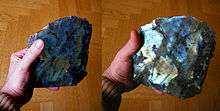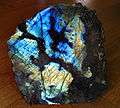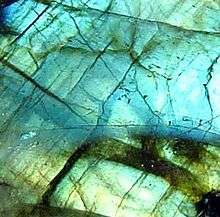Labradorite
| Labradorite | |
|---|---|
|
Labradorite in a polished rock slab | |
| General | |
| Category | Feldspar, tectosilicate |
| Formula (repeating unit) | (Ca,Na)(Al,Si)4O8, where Ca/(Ca + Na) (% anorthite) is between 50%–70% |
| Crystal system | Triclinic |
| Crystal class |
Pinacoidal (1) H-M symbol: (1) |
| Unit cell |
a = 8.155 Å, b = 12.84 Å c = 10.16 Å; α = 93.5° β = 116.25°, γ = 89.133°; Z = 6 |
| Identification | |
| Color | Gray, brown, greenish, blue, yellow, colorless |
| Crystal habit | Crystals typically thin and tabular, rhombic in cross section, striated; massive |
| Twinning | Common by Albite, Pericline, Carlsbad, Baveno, or Manebach twin laws |
| Cleavage | Perfect on {001}, less perfect on {010}, intersecting at near 90°; distinct on {110} |
| Fracture | Uneven to conchoidal |
| Mohs scale hardness | 6 – 6.5 |
| Luster | Vitreous to pearly on cleavages |
| Streak | white |
| Diaphaneity | Translucent to transparent |
| Specific gravity | 2.68 to 2.72 |
| Optical properties | Biaxial (+) |
| Refractive index | nα = 1.554 - 1.563 nβ = 1.559 - 1.568 nγ = 1.562 - 1.573 |
| Birefringence | δ = 0.008 - 0.010 |
| 2V angle | Measured: 85° |
| Dispersion | None |
| Other characteristics | Labradorescence (iridescent) |
| References | [1][2][3] |
Labradorite ((Ca, Na)(Al, Si)4O8), a feldspar mineral, is an intermediate to calcic member of the plagioclase series. It has an anorthite percentage (%An) of between 50 and 70. The specific gravity ranges from 2.68 to 2.72. The streak is white, like most silicates. The refractive index ranges from 1.559 to 1.573. Twinning is common. As with all plagioclase members, the crystal system is triclinic, and three directions of cleavage are present, two of which form nearly right angle prisms. It occurs as clear, white to gray, blocky to lath shaped grains in common mafic igneous rocks such as basalt and gabbro, as well as in anorthosites.
Occurrence
The geological type area for labradorite is Paul's Island near the town of Nain in Labrador, Canada. It has also been reported in Norway and various other locations worldwide.[2]
Labradorite occurs in mafic igneous rocks and is the feldspar variety most common in basalt and gabbro. The uncommon anorthosite bodies are composed almost entirely of labradorite.[4] It also is found in metamorphic amphibolites and as a detrital component of some sediments. Common mineral associates in igneous rocks include olivine, pyroxenes, amphiboles and magnetite.[1]
Labradorescence

Labradorite can display an iridescent optical effect (or schiller) known as labradorescence. The term labradoresence was coined by Ove Balthasar Bøggild, who defined it (labradorization) as follows:[5]
Labradorization is the peculiar reflection of the light from submicroscopical planes orientated in one direction (rarely in two directions); these planes have never such a position that they can be expressed by simple indices, and they are not directly visible under the microscope.
Contributions to the understanding of the origin and cause of the effect were made by Rayleigh (1923), and by Bøggild (1924).[5][6][7]
The cause of this optical phenomenon is phase exsolution lamellar structure,[8] occurring in the Bøggild miscibility gap.[9] The effect is visible when the lamellar separation is between 128 to 252 nm (5.0×10−6 to 9.9×10−6 in); the lamellae are not necessarily parallel;[9] and the lamellar structure is found to lack long range order.[10]
Relationships between lamellar separation and chemical composition have been found for the An (Anorthite) content (calcium rich plagioclase) of the mineral.[8][11]
Some gemstone varieties of labradorite exhibiting a high degree of labradorescence are called spectrolite.
Gallery
-

Labradorite, Ylämaa, Finland
-

Polished labradorite 18x20cm
-

Detail of Labradorite
-
.jpg)
Polished labradorite from UCL Geology collections
-

Labradorite slabs used as floor tiles
-

Labradorite on a feldspar phase diagram
-

Labradorite, museum specimen
-

Labradorite filing (9 karats)
See also
References
- 1 2 Handbook of Mineralogy
- 1 2 Mindat.org
- ↑ Webmineral data
- ↑ Hurlbut, Cornelius S.; Klein, Cornelis, 1985, Manual of Mineralogy, 20th ed., Wiley, p. 456 ISBN 0-471-80580-7
- 1 2 Boggild, O.B. (1924), "On the Labradorization of the Feldspars" (PDF), Kgl. Danske Videnskabernes Selskab. Mathematisk-fysiske Meddelelelser, 6 (3): 1–79
- ↑ Raman, C. V.; Jayaraman, A. (July 1950). "The structure of labradorite and the origin of its iridescence". Proceedings of the Indian Academy of Sciences - Section A. 32 (1): 1–16. doi:10.1007/BF03172469.
- ↑ Lord Rayleigh (3 April 1923), "Studies of Iridescent Colour and the Structure Producing it. III. The Colours of Labrador Felspar", Proceedings of the Royal Society of London. Series A, Containing Papers of a Mathematical and Physical Character, The Royal Society, 103 (720): 34–45, JSTOR 94093
- 1 2 Yan-ju, Peng; Xue-mei, He; Qin-fang, Fang (May 2008), "Exsolution lamellar structure causes of iridescence in labradorite:evidence from TEM", Acta Petrologica Et Mineralogica
- 1 2 Hao, Xie; Jing-cheng, Pei; Li-ping, Li (Feb 2006), "Relation Between Labradorescence and Internal Structure of Labradorite", Geological Science and technology Information
- ↑ Bolton, H. C.; Bursill, L. A.; McLaren, A. C.; Turner, R. G. (1966). "On the origin of the colour of labradorite". Physica status solidi (b). 18: 221. doi:10.1002/pssb.19660180123.
- ↑ MacKenzie, W.S.; Zussman, J., eds. (1974), "23. Electron-optical study of a schiller labradorite", The Feldspars: Proceedings of a NATO Advanced Study Institute, Manchester, 11–21 July 1972, Manchester University Press, 2, pp. 478–490
| Wikimedia Commons has media related to Labradorite. |
| Wikimedia Commons has media related to Labradorescence. |
